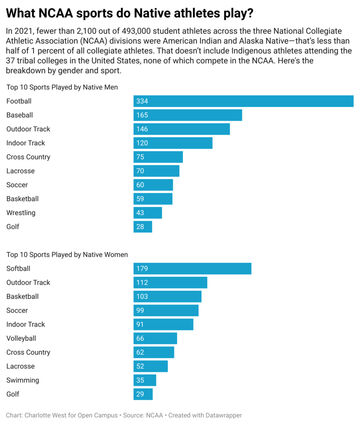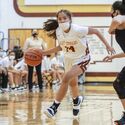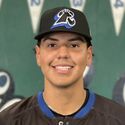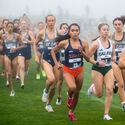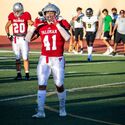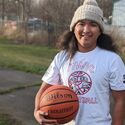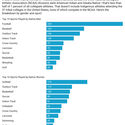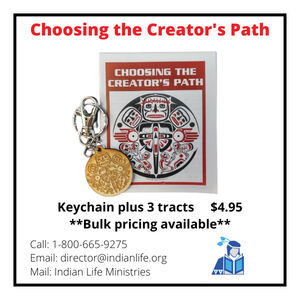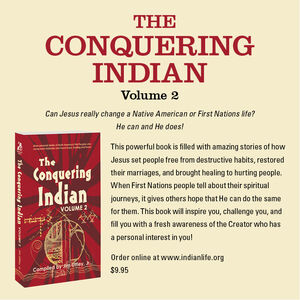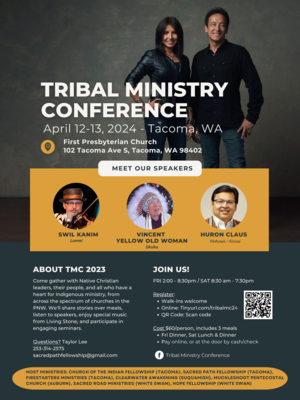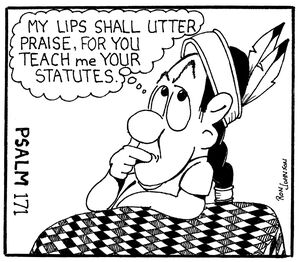Sports provide an important but underutilized path to college for Native students
Last updated 9/30/2022 at 1:16pm

Charlotte West for Open Campus
Deontay Begay, a Navajo student from New Mexico, plays basketball for Northwest Indian College, a tribal college in Bellingham, Wash.
LONG BEACH, Calif.-Two years ago, Deontay Begay was overjoyed when he and his twin brother, Deondre, were recruited to play basketball for Northwest Indian College. It was a way to explore the world beyond Sheep Springs, a rural community of 250 on the Navajo Nation in New Mexico.
But the pandemic ultimately meant his first basketball season was canceled, as was his move to Bellingham, Wash., where the tribal college is located on the Lummi Nation.
Begay, who is Navajo, spent his first year of college studying online through his phone's hotspot from home.
"Sports was a way to get to college," he said. "My family was really big on education, and so they were always encouraging us to get a scholarship for athletics."
If Begay hadn't been recruited to Northwest Indian College, he likely would have stayed close to home and attended the local community college, he said. His aunt, who lives in Bellingham, helped the brothers connect with the coach at the college.
Last fall, the twins finally stepped onto a college court. "We told our aunt that we wanted to go to college and play somewhere off the reservation in another state," he said, "and now we're here."
For Native American students like Begay and his twin, sports can provide a promising avenue to education and increase access to colleges farther from home. However, despite the potential opportunities for recruitment and scholarships, Native American students remain even more underrepresented in college athletics than they are in higher education.
Historically, Native students have had the lowest college-going rates of any racial group. American Indians and Alaska Natives make up around 1 percent of all college students compared to around 3 percent of the U.S. population.
That disparity was exacerbated by the pandemic. There were almost 19 percent fewer first-year Native students enrolled in college in fall 2021 than in fall 2019, according to the National Student Clearinghouse Research Center.
In 2021, fewer than 2,100 out of 493,000 student athletes across the three National Collegiate Athletic Association (NCAA) divisions were American Indian and Alaska Native- that's less than half of 1 percent, a proportion that's stayed about the same over the past decade. That doesn't include Indigenous athletes attending the 37 tribal colleges in the United States, none of which compete in the NCAA.
Sports have always been a cornerstone of Indigenous culture, says Brent Cahwee, co-founder and editor of NDN Sports, an online website dedicated to Native American athletics. Cahwee is a member of the Pawnee Nation of Oklahoma.
Games such as modern lacrosse have Indigenous roots. And, as author Wade Davies writes in his book, Native Hoops: The Rise of American Indians and Basketball, basketball has become the most popular sport in Indian County since it was first introduced in government boarding schools in the early 20th century.
While the sport initially served as a tool of social control and assimilationist policies, Davies argues it's since become an expression of Native culture and sportsmanship. Native basketball has even made its way into pop culture, inspiring an upcoming Netflix drama, Rez Ball, directed by Navajo filmmaker Sydney Freeland.
But despite the prominence of such sports in tribal communities, experts say that college coaches don't focus their outreach on Native communities, which are often located in rural areas. Lack of representation in collegiate sports plays a role, too, making it difficult for Native athletes to see themselves excelling in athletics.
Colleges are missing out on talented Native student athletes, experts say, and students are missing out on educational opportunities.
Tanksi Clairmont, an enrolled member of the Sisseton-Wahpeton Oyate (Dakota) and the Sičangu Lakota Oyate tribes, focused her research during her master's program in education at the University of Minnesota on the lack of opportunities for Native athletes.
Clairmont surveyed 20 basketball college coaches mostly at Division 2 and Division 3 schools about their recruitment efforts as well as their perceptions of Native athletes.
While responses varied from concerns over cultural obligations to doubting Native athletes' ability to cope with leaving their communities, the coaches Clairmont surveyed generally had very little experience in even having a Native athlete on their team, and gave very little thought to specifically recruiting from certain communities, she said.
Reaching rural athletes
Native students living in tribal communities of reservations face difficulties getting seen by recruiters. Tanisha Bitsoi, who is Navajo, coaches girls basketball at Tohatchi High School, located in a town of 800 on the Navajo Nation in New Mexico. "We're in the middle of nowhere, no one even knows who we are," she said.
While two to four players out of a team of 14 generally get recruited each year, she has to go to great lengths to get eyes on her players. Since it is uncommon for college recruiters to travel to rural communities, those teams must travel to be seen, which is not always financially feasible, Bitsoi said.
Still, Bitsoi and her team travel to basketball camps and tournaments during the summer, while the rest of the year she helps her students submit highlight reels. Some students even join larger club teams for their state, in order to gain more exposure and connect with college coaches.
Some Native students who aspire to college athletics transfer to bigger high schools for more opportunities. For Yawaywish Laupsa-Briones, 19, a member of the Soboba Band of Luiseño Indians in Southern California, playing sports at a higher level meant moving away from her reservation.
Her family made the decision to relocate an hour away, allowing Laupsa-Briones to attend another high school with a better quality education and a more competitive softball program, she said.
That introduced her to colleges she'd never even heard of. Her travel team coach, a veteran, connected her to West Point in New York. Laupsa-Briones became the first person in her tribe to attend a military academy after she was recruited to play softball.
"I wanted to serve my people and I wanted to make a difference in this world," Laupsa-Briones said.
Scholarships through sports
For many Native students, economic barriers contribute to difficulties with getting to and through college. Out of all racial groups, Native Americans have one of the highest poverty rates, at more than 20 percent in 2019 according to the Department of Health and Human Services. That means the possibility of earning athletic scholarships can become a powerful motivator for talented student athletes.
Trinity Ruelas, a college senior and member of the Ohkay Owingeh tribe, always wanted to go to college, but she didn't know that running could help her get there. "I didn't come from a high-income family, so [it] was always kind of a concern in the back of my mind growing up that...I would be able to afford college," Ruelas, 22, said.
When her high school coach encouraged her to use running as a tool to pursue college, Ruelas set a goal of getting recruited to a Division 1 school with a scholarship.
During her junior year of high school, she signed to run for California State University Fullerton with a full ride scholarship for Division 1 track. But Reulas is an exception; few American Indian and Alaska Native collegiate athletes play D1 sports, where the biggest scholarships are awarded.
Kayik Wildcat, a member of the Pawnee Nation of Oklahoma, is a baseball player at Lamar Community College, in Colorado. He was a "preferred walk on," which meant he had a guaranteed spot on the team but didn't receive an athletic scholarship. "They wanted me to come here, but didn't have the money," he said.
To help make ends meet, Wildcat works as a resident assistant in the dorms and receives free housing. "[College] is not free, it's not handed to us," Wildcat said of Native students. "We have to work just as hard for it."
The role of community colleges
Wildcat was intentional in his choice of college, despite the lack of a scholarship. He said he might have been recruited to play lower division baseball at a four-year college right out of high school, but his ultimate goal is to play D1. So, he took the junior college route.
"I wanted to do everything I could to put myself in a situation to play D1 baseball," he said.
Tristian Garcia, a member of the San Pasqual Band of Mission Indians, had a similar plan. Although he had his sights set on Division I, he decided to enroll at Palomar College in San Marcos, Calif., when he was recruited to play D2 football. College let him continue to play the game he loves.
After he graduated from high school in 2020, Garcia made a deal with his dad that he'd go to college or get a job. "I wanted to go to school and play football, 'cause you only have one chance at doing that," said Garcia, who was the first member of his immediate family to attend college.
Like many students who graduated during the pandemic, Garcia decided to enroll at Palomar part-time in order to balance work, school, and football practice. He was a "red shirt," which allowed him to practice with the football team but not play in any games, saving a year of eligibility while honing his skills as a player.
As he entered into his sophomore year in fall 2021, Garcia enrolled full time and resumed his position as linebacker for his first game in nearly two years, reminding him of the goal he set for himself as a child -to eventually play professionally. Garcia hopes that after finishing his associate's degree he can transfer to a D1 school like UCLA or USC, which would be the next step towards the NFL.
"Even though I'm at the lowest division . . . I still have high hopes that I can get close to that dream one day," Garcia said.
<<span class=plus_two>strong>Goals beyond sports
While sports might lead to a possible career for a select few, the bigger goal for many Native student athletes is to gain an education and eventually bring those skills back to their communities, said Cahwee of NDN Sports.
To help the Native athletes they recruit with those broader goals, colleges need to do more to support those students once they get there and help them get to graduation, said Clairmont, who is currently going through the recruitment process with her daughter. Coaches should be able to speak about cultural organizations and curriculum for Native students.
"If they were interested in my kid, I would expect those coaches to know their campus and know those resources to say 'Not only do I see you as somebody that would be a fit on my team, but also could fit in on this campus,'" she said.
Charlotte West contributed to this story.
Tess Kazenoff is a freelance journalist and a California State University Long Beach student graduating in the spring of 2022. Her work has appeared in the Long Beach Post and CalMatters.
This story first appeared in Open Campus, a nonprofit news organization focused on higher education.
